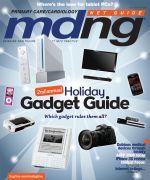Publication
Article
MDNG Primary Care
Tech Talk: Great Gadgets
Author(s):
If you watch television and you haven’t started using a digital video recorder yet, you need to take a closer look at what this gadget can do for your life.
Although I am known as a techie, I am not much of a gadget guy. My office does not employ any “exotic” equipment, other than standard medical instruments, desktop and laptop computers, printers, and of course an EHR. At home, my family and I tend to be late adopters, waiting to purchase a tech product or device until it has been proven in the market and comes down in price. But we do have several favorite “can’t live without” devices, even though they are probably well known to most people. If you watch television and you haven’t started using a digital video recorder (DVR) yet, you need to take a closer look at what this gadget can do for your life. DVRs are basically giant disk drives (similar to the one in a computer) used to record TV shows. The first and most wellknown DVR was TiVo, though nowadays, most cable and satellite providers have their own DVRs built into their settop box. Depending on the size of your DVR’s hard drive, you can record dozens or even hundreds of hours of programming. Better yet, these devices allow you to pause and rewind live television, fast-forward through commercials, and record a season’s worth of shows with the press of a button.
What’s really great about DVRs is their ability to “timeshift” your television watching. This is a fancy way of saying that you can watch the shows you want anytime, instead of when the network programs them. For example, when my wife and I sit down to watch television after the kids have gone to sleep, we don’t just flip channels until we find something interesting and then sit through interminable commercials; instead, we look at the list of shows prerecorded on the DVR and then select whatever we want to watch. We skip the commercials, cutting 20 minutes off an hour-long show. Our children benefit as well, since we can be more thoughtful about what they watch, choosing educational and enriching shows in advance so there is always something good for them to watch. Basically, I won’t watch live TV since being introduced to the DVR.
Another family favorite is satellite radio, which has numerous advantages over plain-old terrestrial radio, starting with the outstanding programming. There is a channel for nearly every genre of music out there. It goes way beyond the typical rock and country fare found on FM and AM stations. Enjoy listening to bluegrass or reggae? How about opera or gospel? The channels for kids are great for long trips, as is the classic radio show channel. Speaking of road trips, one of the best things about owning a satellite radio is being able listen to the same stations from coast to coast. In addition to music, satellite radio offers a plethora of sporting event broadcasts; talk shows; news from CNN, BBC, NPR, CNBC, etc; and 24/7 weather and traffic. Personally, I love jumping from joke to joke through the various comedy stations (though, on family trips this can be a bit difficult, because many of these channels are unedited, and cursing is common).
The last gadget on my short list of tried-and-true products is the wireless data networking card for my laptop computer. I travel a lot in my role as president of AmazingCharts.com, and I cannot always count on getting access to a wireless network hot spot. Wireless data networking “AirCards” plug into a laptop using a USB port, PCMCIA card slot, or an ExpressCard slot. I use Sprint for the data service and have found it to be signifi cantly faster than Verizon, but you should research which carrier provides the best coverage in the geographic areas where you plan to use your laptop most.
AirCards first look for a WiFi connection, and if they can’t find one, they connect to the wireless service carrier’s data network using cell phone technology. Theoretically, with AirCards, you could stand in the middle of Death Valley and still be able to surf the Internet and send e-mail. The truth, though, is that service coverage can be spotty, particularly in remote areas. The carriers promise “broadband speeds where available,” but you will think it crawls compared to your high-speed connection at home or the office. Still, it is better than no Internet access.
Dr. Bertman is Physician Editor-in-Chief of MDNG: Primary Care/Cardiology Edition. He is a Clinical Assistant Professor of Family Medicine at Brown University and president of AmazingCharts.com, a leading developer of EHR software. He is also the founder and president of AfraidToAsk.com, a consumer website focusing on personal medical topics. He is in private practice in Hope Valley, RI.





